This post may contain affiliate ads at no cost to you. See my disclosures for more information.
At Gift of Curiosity, we love exposing kids to STEAM (science, technology, engineering, art, and math).
Erupting soap is a fun and simple STEAM science activity that will be enjoyed by kids of all ages. Plus, this super quick activity only takes a minute or two from start to finish (although we provide ideas for extended learning opportunities below).
Note: Find more science activities on my Science Activities for Kids page!
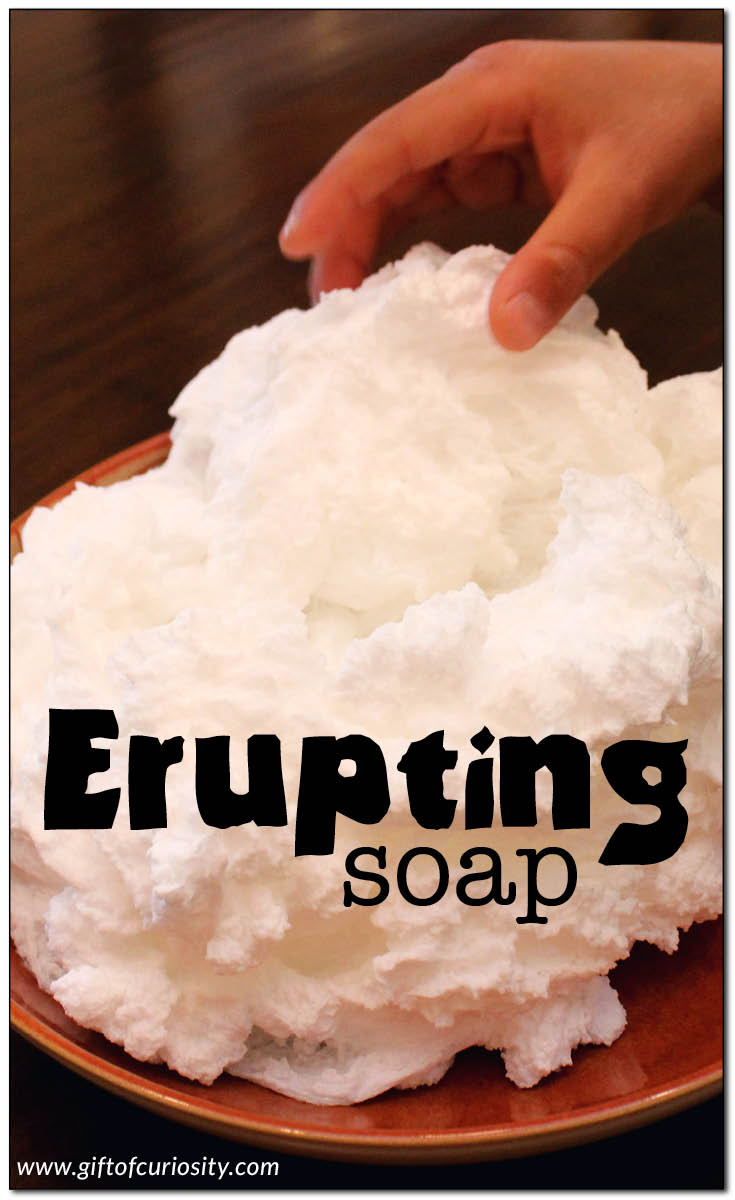
Erupting soap is pretty cool to observe. In a matter of seconds, a regular bar of soap erupts into a large, foamy-looking but solid sort of “sculpture.” Plus, there’s a science lesson to be learned while doing this activity too!
To make erupting soap, you will need the following materials:
- A bar of Ivory soap (you must use Ivory soap as other brands will not work)
- Large, microwave-safe bowl or plate
- Microwave
Grab your bar of Ivory soap and place it into a large, microwave-safe bowl.
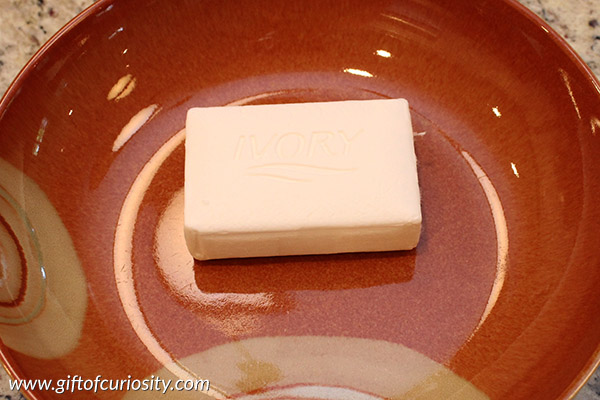
Place your bowl and soap into the microwave. Set your microwave to cook on high for 90 seconds. (You may not need to leave the microwave running for the entire 90 seconds, but it is okay if you do.)
We observed the soap in the microwave. It wasn’t long before it started puffing up and taking on a completely different shape.
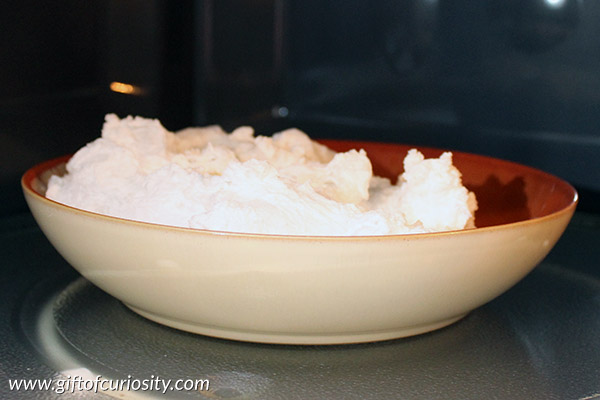
Continue observing the soap for the entire time it is in the microwave. If you notice that it stops growing before the 90 seconds are up, you can stop the microwave and take it out. Note that the bowl may be hot, so a grownup should handle it with caution.
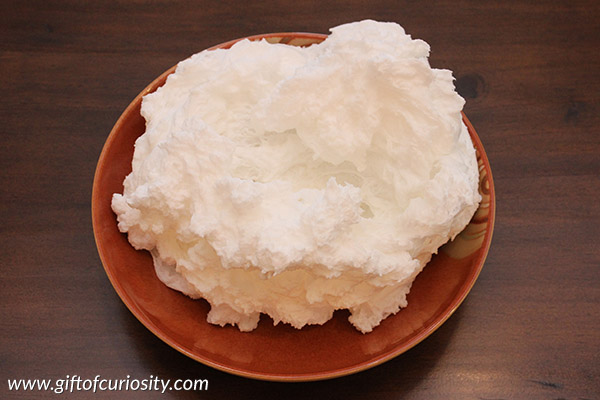
The whole “sculpture” can be picked up and admired, although we found it to be somewhat fragile. The “sculpture” can still be used as soap. Aside from having less moisture compared to when it was in bar foam, the soap is still soap and will work as a cleansing agent just as before.
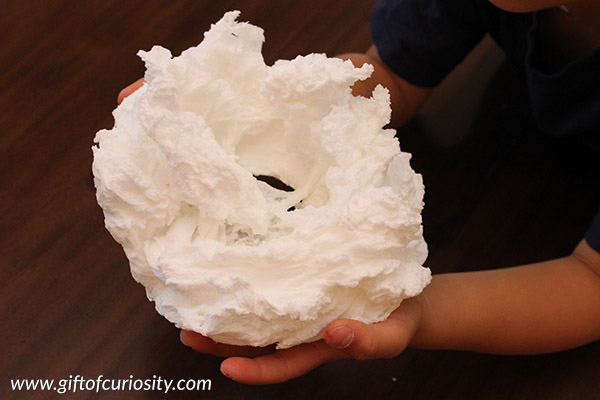
The science behind the activity
Charles’s law is a scientific principle that asserts the following: the volume of a gas is directly proportional to its absolute temperature assuming the pressure stays constant. In layman’s terms, this means that as a gas heats up, it takes up more space.
The high moisture content of Ivory soap combined with its many air pockets makes it ideal for this science activity. When Ivory soap is heated in the microwave the moisture turns to gas (steam). The gas expands, pushing the the solid part of the soap apart and creating the “sculpture” that we see.
The “sculpture” you take out of the microwave is virtually identical in composition to the bar of soap you put into the microwave, with the exception that the “sculpture” has a lower water content.
Ideas for extending the learning
- Have your children make a prediction about what will happen before you microwave the soap. Afterwards, compare their predictions to what actually happened.
- Compare what happens when you microwave Ivory soap with another brand of soap.
- Compare what happens when you microwave Ivory soap and Peeps candy.
- Compare what happens you heat the soap in the microwave and heat the soap on the stove or in an oven. Discuss why the results are not the same. (Hint: it has to do with how quickly the microwave heats the soap; the gasses expand so quickly they force the soap to change shape.)
- Weigh the bar of soap on a kitchen scale before and after putting it in the microwave. Discuss why the soap weighs less after it comes out of the microwave. (Hint: it has to do with the loss of moisture.)
- Cut the bar of soap in half, and microwave just one half. Observe how the cut side expands compared to the non-cut side of the soap.
- Invite your child to take the soap “sculpture” to a bathroom sink and add water to it for washing hands. Discuss why it still works as a soap.
More science activities for kids
More science posts from Gift of Curiosity:
- Dancing raisins
- Candy experiments
- Jumping colors science activity
- Make your own glycerin soap
- Crystallized snowflakes
- Dissecting an apple
- What do ants like to eat?
- Make your own telescope
- The great baking soda and vinegar experiment
- Magic inflating balloons
Find more great science activities on my Science Activities for Kids page and my Science Activities Pinterest board.



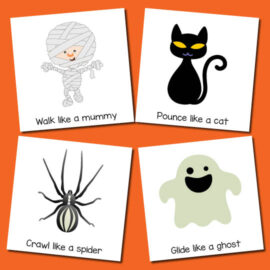
What a fun activity! I will definitely give it a try, thank you for sharing 🙂
Katie,
Who would have ever thought to put ivory soap in a microwave; but, then again who would have ever thought to pop popcorn (isn’t that the same idea, that the moisture inside the kernels of corn when heated turns to a gas, thus making the kernel of corn “pop it’s shell open”…walla…popcorn! Could extend this “erupting soap” activity by bringing in the hot air popcorn popper and lay it in the middle of a large sheet or blanket with the kids sitting around it in a circle with bowls to “catchj” the popping corn. It’s a hoot, I’ve done this with my hot air popper, the kids love it! 😀
I love your idea of connecting this to pop corn! Thank you for sharing.
Hi Katie,
Will this experiment do any damage to the microwave or make it smell like soap after? Thanks for all of the great ideas!
Best,
Amy
As with anything, do this experiment at your own risk. However, if you have a large enough microwave and a large enough bowl to put the soap in, you are likely to be fine. You can also closely observe the soap as it erupts and stop the microwave immediately if you feel the eruption is getting too big.